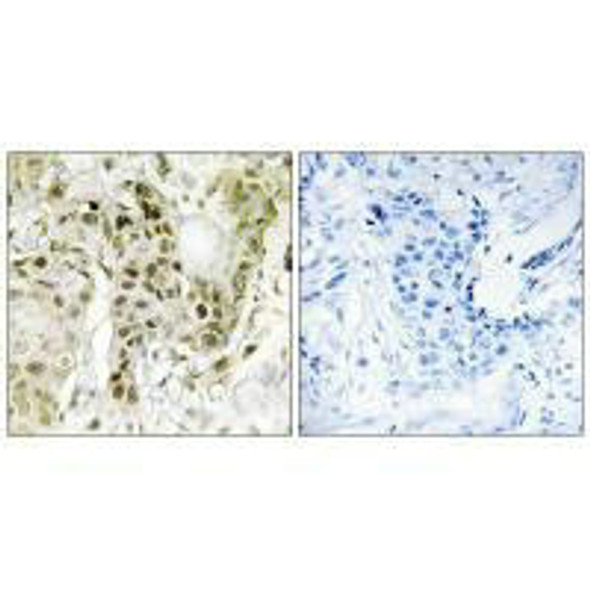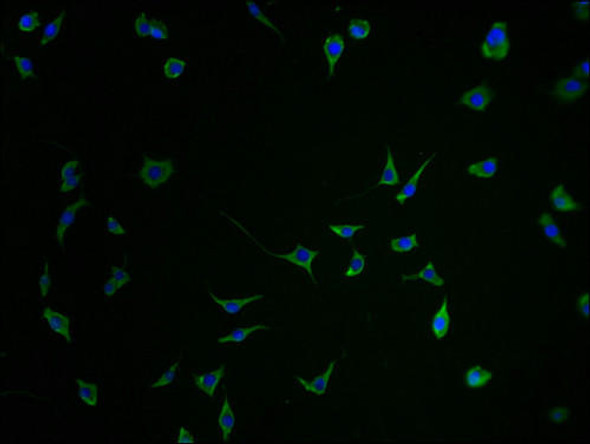Description
BCOR Antibody (PACO00461)
The BCOR Antibody (PACO00461) is a valuable tool for researchers studying the BCOR protein, which plays a key role in various cellular processes including gene regulation and embryonic development. This polyclonal antibody, produced in rabbits, is highly specific to human samples and has been validated for use in Western blot applications. By targeting the BCOR protein, this antibody allows for the detection and analysis of BCOR expression in different cell types, making it ideal for research in the fields of genetics and developmental biology.
BCOR is known to interact with various transcription factors and chromatin-modifying enzymes, suggesting its involvement in gene regulation and epigenetic processes. Additionally, mutations in the BCOR gene have been linked to certain genetic disorders and cancers, highlighting the importance of studying its function and regulation. By using the BCOR Antibody, researchers can gain valuable insights into the role of BCOR in normal cellular processes and disease states, ultimately leading to potential therapeutic advancements.
| Antibody Name: | BCOR Antibody |
| Antibody SKU: | PACO00461 |
| Size: | 50ug |
| Host Species: | Rabbit |
| Tested Applications: | ELISA, WB, IHC |
| Recommended Dilutions: | WB:1:500-1:2000, IHC:1:100-1:300 |
| Species Reactivity: | Human, Mouse |
| Immunogen: | synthesized peptide derived from the Internal region of human BCoR. |
| Form: | Liquid |
| Storage Buffer: | Liquid in PBS containing 50% glycerol, 0.5% BSA and 0.02% sodium azide. |
| Purification Method: | The antibody was affinity-purified from rabbit antiserum by affinity-chromatography using epitope-specific immunogen. |
| Clonality: | Polyclonal |
| Isotype: | IgG |
| Conjugate: | Non-conjugated |
| Synonyms: | BCOR; KIAA1575; BCL-6 corepressor; BCoR |
| UniProt Protein Function: | BCOR: Transcriptional corepressor. May specifically inhibit gene expression when recruited to promoter regions by sequence specific DNA-binding proteins such as BCL6 and MLLT3. This repression may be mediated at least in part by histone deacetylase activities which can associate with this corepressor. Involved in the repression of TFAP2A; impairs binding of BCL6 and KDM2B to TFAP2A promoter regions. Via repression of TFAP2A acts as a negative regulator of osteo-dentiogenic capacity in adult stem cells; the function implies inhibition of methylation on histone H3 'Lys-4' (H3K4me3) and 'Lys-36' (H3K36me2). Defects in BCOR are the cause of microphthalmia syndromic type 2 (MCOPS2). Microphthalmia is a clinically heterogeneous disorder of eye formation, ranging from small size of a single eye to complete bilateral absence of ocular tissues (anophthalmia). In many cases, microphthalmia/anophthalmia occurs in association with syndromes that include non-ocular abnormalities. MCOPS2 is a very rare multiple congenital anomaly syndrome characterized by eye anomalies (congenital cataract, microphthalmia, or secondary glaucoma), facial abnormalities (long narrow face, high nasal bridge, pointed nose with cartilages separated at the tip, cleft palate, or submucous cleft palate), cardiac anomalies (atrial septal defect, ventricular septal defect, or floppy mitral valve) and dental abnormalities (canine radiculomegaly, delayed dentition, oligodontia, persistent primary teeth, or variable root length). Belongs to the BCOR family. 4 isoforms of the human protein are produced by alternative splicing. |
| UniProt Protein Details: | Protein type:Transcription, coactivator/corepressor Chromosomal Location of Human Ortholog: Xp11.4 Cellular Component: mitochondrion; nucleus; PcG protein complex Molecular Function:heat shock protein binding; histone deacetylase binding; protein binding; transcription corepressor activity; transcription factor binding; ubiquitin-protein ligase activity Biological Process: heart development; negative regulation of bone mineralization; negative regulation of histone H3-K36 methylation; negative regulation of histone H3-K4 methylation; negative regulation of transcription from RNA polymerase II promoter; negative regulation of transcription, DNA-dependent; odontogenesis; palate development; specification of axis polarity Disease: Microphthalmia, Syndromic 1; Microphthalmia, Syndromic 2 |
| NCBI Summary: | The protein encoded by this gene was identified as an interacting corepressor of BCL6, a POZ/zinc finger transcription repressor that is required for germinal center formation and may influence apoptosis. This protein selectively interacts with the POZ domain of BCL6, but not with eight other POZ proteins. Specific class I and II histone deacetylases (HDACs) have been shown to interact with this protein, which suggests a possible link between the two classes of HDACs. Several transcript variants encoding different isoforms have been found for this gene. A pseudogene of this gene is found on chromosome Y.[provided by RefSeq, Jun 2010] |
| UniProt Code: | Q6W2J9 |
| NCBI GenInfo Identifier: | 57012588 |
| NCBI Gene ID: | 54880 |
| NCBI Accession: | Q6W2J9.1 |
| UniProt Secondary Accession: | Q6W2J9,Q29RF6, Q6P4B6, Q7Z2K7, Q8TEB4, Q96DB3, Q9H232 Q9H233, Q9HCJ7, Q9NXF2, D3DWB3, D3DWB4, |
| UniProt Related Accession: | Q6W2J9 |
| Molecular Weight: | 186,235 Da |
| NCBI Full Name: | BCL-6 corepressor |
| NCBI Synonym Full Names: | BCL6 corepressor |
| NCBI Official Symbol: | BCOR |
| NCBI Official Synonym Symbols: | MAA2; ANOP2; MCOPS2 |
| NCBI Protein Information: | BCL-6 corepressor |
| UniProt Protein Name: | BCL-6 corepressor |
| Protein Family: | BCL-6 corepressor |
| UniProt Gene Name: | BCOR |
| UniProt Entry Name: | BCOR_HUMAN |











